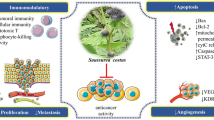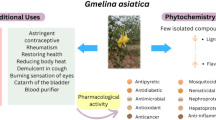Abstract
This review was focused to collect and exemplify the data on traditional uses, phytochemistry, and pharmacological outline of C. oppositifolia, and thereby recognize the current obscurities and highlight the scope and opportunities for future research on the plant. A thorough literature search was performed on C. oppositifolia in the online databases such as Scopus, PubMed/Medline, Science direct, Scifinder, EMBASE, Web of Science, Google scholar, and Elsevier. C. oppositifolia belongs to family Lamiaceae, was widely used in the traditional system of medicine for treating various human ailments. Further, phytochemicals such as acteoside, chrysin, negletein, ladanein, betulonic acid, apigenin, caffeic acid, quercetin, anisofolin A, apigetrin, forsythoside A, β-sitosterol, ferulic acid, and its derivatives were isolated from various parts of C. oppositifolia. Additionally, the plant has been scientifically validated to possess antifertility, anti-ulcer, hepatoprotective, antimicrobial, anti-oxidant, cardioprotective, anti-inflammatory, wound healing, anti-convulsant, and antihypertensive activities in various experimental models. With the available literature we can conclude that despite of enormous traditional uses, the C. oppositifolia has not been explored for its beneficial effects on cataract, rheumatism, joint pain, bleeding disorders, and dysentery. Also, there is a need for clinical studies to explore the efficacy, safety, and toxicity in humans.
Graphic abstract








Similar content being viewed by others
References
Ajaib M, Abid S, Anjum M, Noshad Q, Siddiqui MF, Iqbal MA (2018) Phytochemical, antibacterial and antifungal activities of leaves and bark of Colebrookea oppositifolia: an ethnomedicinal plant. Pure Appl. Biol. 7(1):138–151
Akhtar N, Haq I, Mirza B (2018) Phytochemical analysis and comprehensive evaluation of antimicrobial and antioxidant properties of 61 medicinal plant species. Arab J Chem 11(8):1223–1235
Ali I, Sharma P, Suri KA, Satti NK, Dutt P, Afrin F, Khan IA (2011) In vitro antifungal activities of amphotericin B in combination with acteoside, a phenylethanoid glycoside from Colebrookea oppositifolia. J Med Microbiol 60:1326–1336
Amjad MS, Arshad M, Saboor A, Page S, Chaudhari SK (2017) Ethnobotanical profiling of the medicinal flora of Kotli, Azad Jammu and Kashmir, Pakistan: Empirical reflections on multinomial logit specifications. Asian Pac J Trop Med 10(5):503–514
Ansari S, Dobhal MP, Tyagi RP, Joshi BC, Barar FSK (1982) Chemical investigation and pharmacological screening of the roots of Colebrookia oppositifolia Smith. Pharmazie 37(1):70
Anwar R, Khalil MU, Latif A (2018) Investigation of anti-hypertensive activity of standardized Colebrookea oppositifolia methanolic extract and elucidation of possible mechanism of action. Front. Pharmacol. Conference Abstract: international conference on drug discovery and translational medicine 2018 (ICDDTM '18) “Seizing opportunities and addressing challenges of precision medicine”. https://doi.org/10.3389/conf.fphar.2018.63.00056
Ashish AC, Manisha A, Dinesh RS, Dhiman S, Swati PJ (2016) A new dinor-cis-labdane diterpene and flavonoids with antimycobacterium activity from Colebrookea oppositifolia. Planta Med Lett 3(1):e20–e24
Bhatia H, Sharma YP, Manhas RK, Kumar K (2014) Ethnomedicinal plants used by the villagers of district Udhampur, J&K. India J Ethnopharmacol 151:1005–1018
Chopra RN, Nayar SL, Chopra IC (1956) Council of scientific and industrial research. Glossary of Indian Medicinal Plants, CSIR Publication, New Delhi
CSIR (1956) The wealth of India: a dictionary of Indian raw materials and industrial products, vol 2. Council of Scientific and Industrial Research Publications, New Delhi, New Delhi, p 1956
Differding E (2017) The drug discovery and development industry in India—two decades of proprietary small-molecule R&D. Chem Med Chem 12(11):786–818
Gairola S, Sharma J, Bedi YS (2014) A cross-cultural analysis of Jammu, Kashmir, and Ladakh (India) medicinal plant use. J Ethnopharmacol 155:925–986
Gangwar K, Deepali K, Gangwar RS (2010) Ethnomedicinal plant diversity in Kumaun. Himalaya of Uttarakhand, India. Nat Sci 8(5):66–78
Ghaisas MM, Surbhi S, Ganu GP, Limaye RP (2010) Antiulcer activity of Colebrookea oppositifolia Sm. Res J Pharmacol Pharmacodyn 2(1):66–70
Ghimire K, Bastakoti RR (2009) Ethnomedicinal knowledge and healthcare practices among the Tharus of Nawalparasi district in central Nepal. Forest Ecol Manag 257:2066–2072
Ghulam NQ, Om Parkash S, Kasturi LB, Krishan AS, Bishan DG, Bupinder SJ, Bal Krishan K, Naresh KS, Musarat A, Bal Krishan C, Neelam S, Gurdarshan S (2007) Isolation of the hepatoprotective agent acteoside from Colebrookea Oppositifolia. EP1617853B1 (European Patent-2007). https://data.epo.org/publication-server/rest/v1.0/publication-dates/20071024/patents/EP1617853NWB1/document.pdf
Gupt RS, Yadav RK, Dixit VP, Dobhal MP (2001) Antifertility studies of Colebrookea oppositifolia leaf extract in male rats with special reference to testicular cell population dynamics. Fitoterapia 72(3):236–245
Haldar PK, Kush B, Arun Kumar P, Girraj T, Braj KT, Devendra Singh NS, Dhananjay G, Shivani K, Glob J (2011) In vitro–in vivo evaluation of cardioprotective effect of the leaf extract of Colebrookea oppositifolia sm. Trends Pharm Sci 2(3):310–324
Joshi AR, Joshi K (2000) Indigenous knowledge and uses of medicinal plants by local communities of the Kali Gandaki Watershed Area, Nepal. J Ethnopharmacol 73:175–183
Khullar M, Sharma A, Wani A, Sharma N, Sharma N, Chandan BK, Kumar A, Ahmed Z (2019) Acteoside ameliorates inflammatory responses through NF-kB pathway in alcohol-induced hepatic damage. Int Immunopharmacol 69:109–117
Kritikar KR, Basu BD (1987) Indian medicinal plants, 1987 edition, 4th edn. International Publishers, Deheradun
Kumar B, Vijayakumar M, Govindarajan R, Pushpangadan P (2007) Ethnopharmacological approaches to wound healing—exploring medicinal plants of India. J Ethnopharmacol 114:103–113
Kumar S, Gustav J, Dobos GJ, Rampp T (2017) The significance of ayurvedic medicinal plants. Evid Based Complem Altern Med 22(3):494–501
Lo ACT, Chan K, Yeung JHK, Woo KS (1992) The effects of Danshen (Salvia miltiorrhiza) on pharmacokinetics and dynamics of warfarin in rats. Eur J Drug Metab Pharmacokinet 17(4):257–262
Madhava Chetty K, Sivaji K, Tulasi RK (2008) Flowering plants of chittoor district—Andhra Pradesh, India, 1st edn. Students Offset Printers, Tirupati
Madhavan V, Yadav DK, Anita M, Yoganarasimhan SN (2009) Wound healing activity of aqueous and alcohol extracts of leaves of Colebrookea oppositifolia Smith. Ind Drugs 46(3):209–213
Mahapatra SK, Mookerjee M, Roy DS, Karak P, Das S, Dastidar SG (2013) Evaluation of antimicrobial potentiality of a flavonoid, isolated from the leaf of the plant Colebrookea oppositifolia. Int J Biol Pharmaceut Res 4(4):225–230
Malika K, Ahmada M, Zhang G, Rashid N, Zafar M, Sultanaa S, Shah SN (2018) Traditional plant based medicines used to treat musculoskeletal disorders in Northern Pakistan. Eur J Integrat Med 19:17–64
Malla B, Chhetri RB (2009) Indigenous knowledge on ethno-botanical plants of Kavrepalan chowk district, Kathmandu University. J Sci Eng Technol 5(2):96–109
Mukherjee PK, Mukherjee K, Hermans-Lokkerbol ACJ, Verpoorte R, Suresh B (2001) Flavonoid content of Eupatorium glandulous and Colebrookea oppositifolia. J Nat Remedies 1(1):21–24
Nadkarni KM (1976) Indian material medica, vol 1. Bombay Popular Prakashan, Bombay
Nishith RB, Himadri SP, Prasanna KK, Prakash KH, Subhankar N, Harikant T (2012) In vitro evaluation of antioxidant activity of Colebrookea oppositifolia Smith. Int J Drug Dis Herb Res 2(1):296–300
Pan SY, Litscher G, Gao SH, Zhou SF, Yu ZL, Qi Chen HQ, Zhang SF, Tang MK, Sun JN, Ko KM (2014) Historical perspective of traditional indigenous medical practices: the current renaissance and conservation of herbal resources. Evid Based Complem Alternat Med 2014:525340
Ramadas SR, Ghotge NS, Ashalata S, Mathur NP, Gour V, Rao S (2000) Ethnoveterinary remedies used in common surgical conditions in some districts of Andhra Pradesh and Maharashtra, India. Ethnobotany 12:100–112
Reddy RV, Reddy BA, Gunasekar D (2009) A new acylated flavone glycoside from Colebrookea oppositifolia. Asian Nat Prod Res 11:183–186
Sahoo N, Manchikanti P (2013) Herbal drug regulation and commercialization: an Indian industry perspective. J Altern Complement Med 19(12):957–963
Saiqa I, Mehvesh BM, Muhammad SKA, Shehla A, Shahid R (2016) Pharmacognostic studies of aerial parts of Colebrookea oppositifolia Sm. Ann Phytomed 5(2):161–167
Sardar PR, Manik SR (2017) GC-MS analysis of aromatic compounds from leaves of Colebrookea oppositifolia Smith. Int J of Life Scie 5(2):241–246
Sharma J, Gairola S, Gaur RD, Painuli RM, Siddiqi TO (2013) Ethnomedicinal plants used for treating epilepsy by indigenous communities of sub-Himalayan region of Uttarakhand. India J Ethnopharmacol 150:353–370
Shirsat RP, Koche DK, Suradkar SS, Kokate PS, Bhadange DG (2014) Two bioactive compounds from leaf extracts of Colebrookea oppositifolia Smith. Ind J App Pure Biol 29(1):61–65
Shirsat R, Suradkar S, Koche D (2011) Antioxidant activity and total polyphenol content of aqueous extracts from three selected lamiaceae members. Ind J Pharmaceut 2(1):43–45
Singh SP, Singh SK, Tripathi SC (1983) Antifungal activity of essential oils of some Labiatae plants against dermatophytes. Ind Perfumer 27(4):171–173
Subba B, Basnet P (2014) Antimicrobial and antioxidant activity of some indigenous plants of Nepal. J Pharmacog Phytochem 3(1):62–67
Tyagi S, Saraf S, Ojha AC, Rawat GS (1995) Chemical investigation of some medicinal plants of Shiwalik hills. Asian J Chem 7:165–170
Upadhyaya OP, Kumar K, Tiwari RK (1998) Skin treatments of Bihar plants. Pharmaceut Biol 36:20–24
Venkateshappa SM, Sreenath KP (2013) Potential medicinal plants of lamiaceae. Am Int J Res Formal Appl Nat Sci 3(1):82–87
Verma SK, Parrek D, Singhal R, Chauhan AK, Parashar P, Dobal MP (2012) Ferulic acid ester from Colebrookea oppositifolia. Ind J Chem 51B:1502–1503
Vijaya RA, Madhu KP, Ganga RB (2011) Anti-Inflammatory activity of methanolic leaf extract of Colebrookea oppositifolia. Int J Pharm Res Develop 3(7):68–72
Viswanatha GL, Venkataranganna MV, Prasad NBL, Hanumanthappa S (2018) Chemical characterization and cerebroprotective effect of methanolic root extract of Colebrookea oppositifolia in rats. J Ethnopharmacol 223:63–75
Viswanatha GL, Venkatarangannam MV, Prasad NBL (2017) Ameliorative potential of Colebrookea oppositifolia methanolic root extract against experimental models of epilepsy: Possible role of GABA mediated mechanism. Biomed Pharmacother 90:455–465
Viswanatha GL, Yogish Kumar H, Venkataranganna MV, Prasad NBL, Shylaja H (2019) Anticonvulsant activity guided isolation of acteoside from methanolic root extracts of Colebrookea oppositifolia Smith. J Biol Active Prod Nat 9(5):328–334
Viswanatha GL, Sowmya GP, Hanumanthappa S, Yogananda M (2020a) Methanolic stem extract of Colebrookea oppositifolia attenuates epilepsy in experimental animal models: possible role of GABA pathways. J Biol Active Prod Nat 10(1):44–58
Viswanatha GL, Shylaja H, Kishore DV, Venkataranganna MV, Prasad NBL (2020b) Acteoside isolated from colebrookea oppositifolia smith attenuates epilepsy in mice via modulation of gamma-aminobutyric acid pathways. Neurotox Res. https://doi.org/10.1007/s12640-020-00267-0
Viswanatha GL, Drishya M, Kishore DV, Yogananda M (2020c) Characterization and anti-stroke activity of stem extract of Colebrookea oppositifolia Smith. J Biol Active Prod Nat 10(3):250–263
Yang F, Li XC, Wang HQ, Yang CR (1996) Flavonoid glycosides from Colebrookea Oppositifolia. Phytochemistry 42:867–869
Acknowledgements
Authors greatly acknowledge JSS Academy of Higher Education & Research (JSS AHER), Mysore, JNT university Anantapur and Connexios Life sciences Pvt. Ltd for providing necessary facilities to carryout the literature work and drafting the article.
Funding
None.
Author information
Authors and Affiliations
Corresponding author
Ethics declarations
Ethical statement
This article does not contain any studies with human participants or animals performed by any of the authors.
Conflict of interest
Gollapalle L. Viswanatha has no conflict of interest. H. Shylaja has no conflict of interest. H. Yogish Kumar has no conflict of interest. M. V. Venkataranganna has no conflict of interest. N. B. L. Prasad has no conflict of interest.
Additional information
Publisher's Note
Springer Nature remains neutral with regard to jurisdictional claims in published maps and institutional affiliations.
Rights and permissions
About this article
Cite this article
Viswanatha, G.L., Shylaja, H., Kumar, H.Y. et al. Traditional uses, phytochemistry, and ethnopharmacology of Colebrookea oppositifolia Smith: a mini-review. ADV TRADIT MED (ADTM) 21, 209–229 (2021). https://doi.org/10.1007/s13596-020-00513-y
Received:
Accepted:
Published:
Issue Date:
DOI: https://doi.org/10.1007/s13596-020-00513-y




